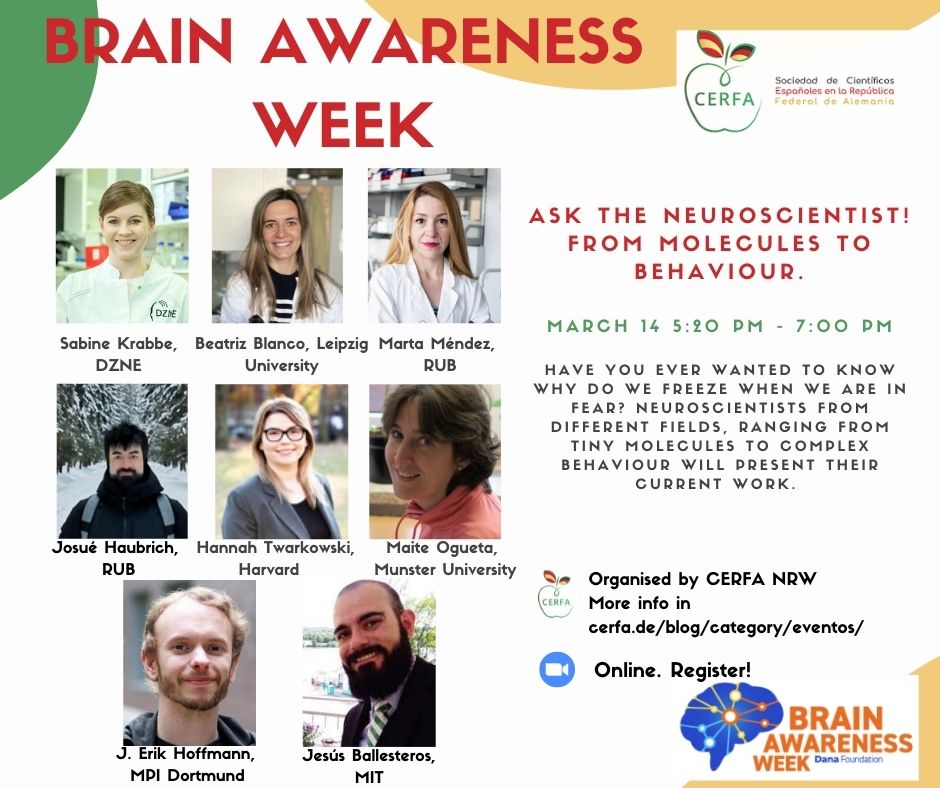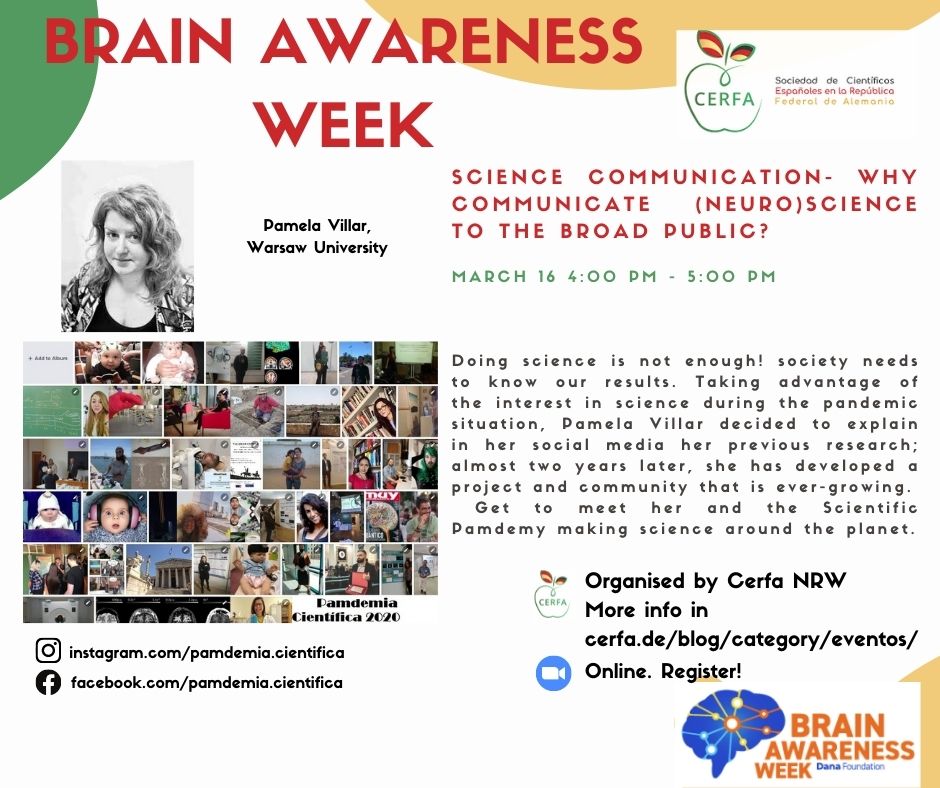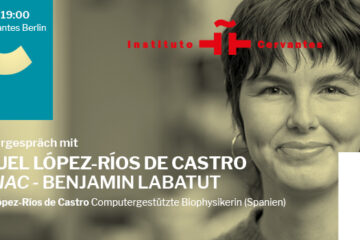The Brain Awareness Week is a global campaign to foster public enthusiasm and support for brain science . This March, CERFA joins efforts to the campaign bringing our first CERFA Brain Awareness Week to our community, sharing the wonders of the brain and the impact that brain science has on our everyday lives.
In this two day series, we will meet a broad spectrum of scientists, from junior scientists to more more experienced ones, as well as a well-known science communicator; they all seek to elucidate how our brain works.
On March 14th at 4 pm, we will have a series of short talks by the young scientists, followed by some longer talks by more experienced researchers, at 5:20pm, to whom you can send questions in advance.
On the March 16th, at 4:00 pm, Pamela Villar will give us a hint on the differences between effective communication, divulgation and dissemination of science.
Are you ready to join? Then, please register in advance here
Agenda
How much do we know about our brain? Can we trace the neuron signals? Can rats understand music? In a series of 3 min presentations, young scientists from around the world will tell us what they do to advance in the knowledge of how we feel, perceive and behave. The series will be followed by a round table of questions from participants and the attending public. Depending on the number of participants and specialities, speakers can be thematically organized in one or more slots. With this activity, we aim to promote the dissemination of knowledge in neuroscience research, as well as tackle the interaction of people studying different aspects of the brain.
Speakers (In order of appearance)
Isabel López, Uniovi. “The impact of Western Diet on Cognition: An unsolved Condundrum”. Neuroscientists mostly agree that long-term consumption of a Western dietary pattern causes cognitive impairment. Unexpectedly, feeding rodents on this type of diet from gestation until adulthood can actually enhance spatial learning and memory, showing sex-dependent effects.
Natalie Babushkina, RUB. “Noradrenaline and dopamine as a learning signal”. The ability to encode novel information that differs from our previous experience is critical for our survival. The question is how does our brain distinguish novel salient information from irrelevant one? Today I am going to shed light on the process of how dopamine and noradrenaline participate in memory creation".
Eloy Parra Barrero, RUB. “How we keep track of where we come from and where we are going”. To learn that your friend’s kitchen is to the left of the living room, you need to keep track of the steps that led you from one to the other. To then navigate between them, you need to keep in mind where you are going and the steps that lay ahead. In this talk, I will introduce how such past and future locations are represented by hippocampal place cells at different phases of the theta oscillation.
Arthur Laja, RUB. “Using neuronal tracers to light up the connections in the brain”. Neuronal tracers of many kinds are used to show how brain areas communicate with each other. How do they work and what do they tell us? Tune in to find out!
Gabriele Russo, RUB. “Don’t stress your mind, we’re neuroimaging just fine“. Research employing awake functional Magnetic Resonance Imaging (fMRI) has to face acute stress caused by physical restraint and loud MRI noise. Stress can generate biases in neuroimaging data, therefore carefully optimized strategies are essential in the field.
Laura Dolón, RUB. “Place cells- Neuron, tell me where to go!”. During extinction, we understand that a previously learned behaviour is no longer adaptative. The hippocampus is involved in the encoding of this learning phase. However, to what extent hippocampal place cells contributes to extinction learning of appetitive experience remains still unclear.
Violeta Caragea, RUB. “ The Plastic Brain and Dopamine“. Dopamine is probably the most famous neurotransmitter looking by the titles of books, songs and movies it inspired. One of the reasons for that might be its role in motivation and addiction, but psychosis or motor dysfunctions (see its role in Parkinson's disease) are by far of similar importance. Still, trying to modulate dopamine levels in the brain might not be so easy. In my short talk, I will focus on how playing around with dopamine mechanisms of action is affecting both synaptic plasticity and memory.
Daniel García Rodriguez. Evotec, Hamburg. “ Neuroscience at the industry: From histology to Neuromarketing”. Neuroscience has rapidly developed in the last few years. In the beginning, classical studies in Neuroscience were focused on a cellular-molecular level combined with an elementary knowledge of the human brain anatomy. Fast forward to nowadays, alongside the rise of the pharmaceutical industry, this discipline has been able to grow in many other different ways, which has been used in 3D modelling, the well-known iPSCs, or even machine learning and neuromarketing.
Have you ever wanted to know why do we freeze when we are in fear? Senior neuroscientist specializing in different fields, ranging from tiny molecules to complex behaviour will present their current work in the field. But they will not be alone! Beforehand, you will have the opportunity to send us questions about their topics through our social media, and at the end of the session, they will be answering those received in advance by the general public!
Meet the speakers:
Sabine Krabbe, DZNE, Bonn. “Amygdala Circuits for Associative Learning”. The amygdala is known to be involved in simple forms of emotional learning. Its appropriate function is particularly important under conditions of immediate threats such as in fear learning. In this talk, I will provide an overview of how distinct amygdala neuron types contribute to the acquisition and extinction of conditioned fear memories.
Jan-Erik Hoffmann.Head of Protein Chemistry Facility at MPI of Molecular Physiology. Chemical protein modifications, how to label an antibody? Jan-Erik Hoffmann will explain to us different methods for chemical protein modifications such as side chain modification and protein semi-synthesis. Examples include fluorescently labelled antibodies and other reagents commonly used in neuroscience.
Marta Méndez-Couz, RUB. “Appetitive extinction, a disrupted brain dialogue to psychosis”. It is mid-September, the weather is perfect and you decide to go for ice cream, just to arrive at your favourite shop and … oh snap! It is closed for the winter. After a moment of frustration, you will probably change your plans until next summer. This process is called appetitive extinction learning, and it naturally allows us to adapt to our environment. However, when extinction fails, it can lead to pathological and behavioural maladaptive dysfunctions, such as addictions or psychosis. We will discuss the time-locked dialogue between the hippocampus, prefrontal cortex and amygdala in these processes.
Jesus Ballesteros, MIT. “Brain Rhythms Under Anesthesia”. Did you know that your brain works mixing rhythms? It's doing it right now. Did you know that when these rhythms change, your mental state changes as well? It happens to you every night. Did you know that anaesthesia can be used to investigate how all this happens? I will tell you how some well-known molecules are used to completely change human and animal behaviour, millions of times per day all around the globe when doctors and veterinarians use anaesthesia. I will also tell you how these same molecules are used to understand very basic mechanisms about how your brain works.
Hannah Twarkoski. Harvard School of Medicine. “Imaging episodic memory over time – the role of inhibitory neurons in memory”. Consolidation episodic memories combine information about past experiences including events, places and people. As time goes by, these memories lose details. Here, we use a miniature microscope, implanted onto the skull of adult mice, to visualize neuronal activity of excitatory neurons as mice form and consolidate a memory over two weeks. Previous work suggests that inhibitory input onto these excitatory neurons is beneficial for memory consolidation. We test this by increasing inhibition in these mice and can show direct evidence that it indeed improves memory consolidation e.g. through altered interaction of two important brain regions, the hippocampus and anterior cingulate cortex, during sleep.
Maite Ogueta. Munster University. “The amazing brain of the tiny fly”. We are used to watching fruit flies feast on our kitchens in summer, but they are one of the most amazing model animals to study the link between genes and behaviour. From flying, learning and memory, to courtship and sleep, these tiny animals have been broadly studied for their complex behaviour.
Josué Haubrich, RUB.” How does trauma shape memory formation?” Memories are flexible and can have their content updated by new experiences. Such flexibility allows them to maintain their relevance in a changing world. However, memories of very fearful events often lack such flexibility and are resistant to change. I will be summarizing the mechanisms by which normal memories are updated and why traumatic ones become engrained in the brain.
Beatriz Blanco Redondo- Research Associate at Leipzig University. “ALS, from bench to clinic”. Amyotrophic lateral sclerosis (ALS) is genetically complex and can be caused by mutations in a large and growing number of genes encoding proteins of diverse function. Using mouse genetics, we have generated and characterized several animal and cellular models of ALS to explore molecular mechanisms of disease and to elucidate pathways of motor neuron degeneration that may be targets for drug discovery. Using an experimental drug, we were able to suppress and lower levels of FUS gene, a toxic protein in the patient’s neurons and in mice with the disease.
Pamela Villar. Warsaw University.
We know it is not enough to do science, we need to share our results with society. Taking advantage of the interest in Science that appeared during the pandemic situation, Pamela Villar, from the University of Warsaw, decided to explain in her social media her previous research; almost two years after this moment, she has developed a project and community that is ever-growing. Get to meet her and the Scientific Pandemy making science around the planet. 


